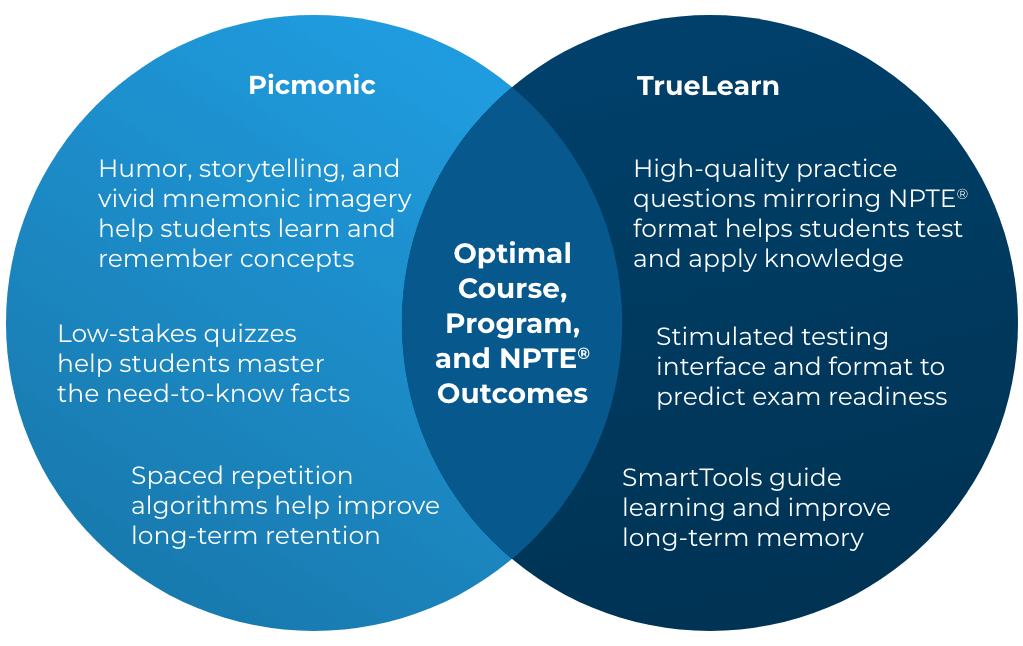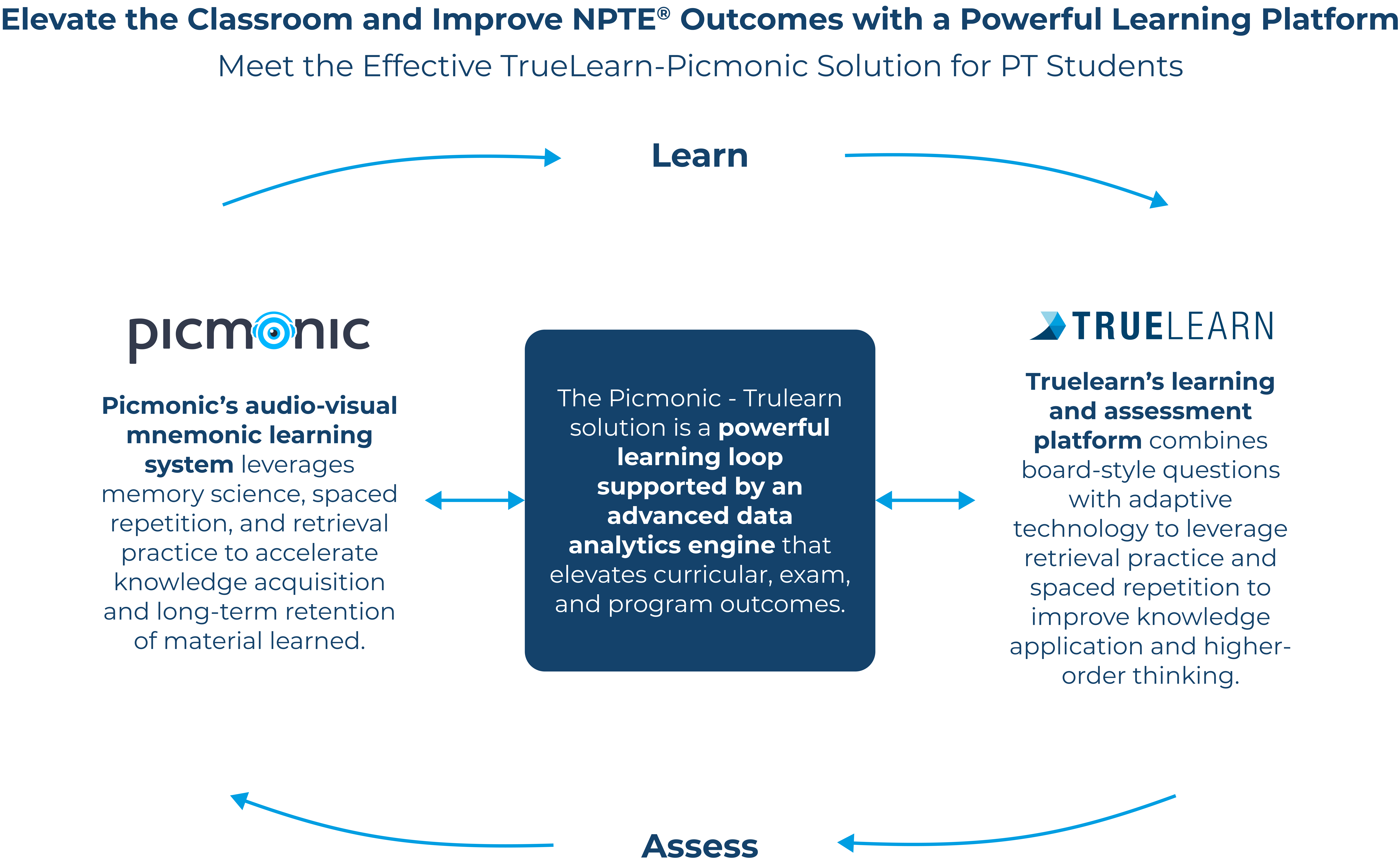Six Criteria to Look for in Physical Therapy Curriculum Resources

Physical therapy (PT) educators are under increasing pressure to deliver a curriculum that not only prepares students for clinical practice but also improves first-time NPTE® pass rates, boosts classroom engagement, and supports diverse learning needs. With so many options available, choosing the right physical therapy curriculum resources has become more complex—and more important—than ever.
It’s not just about covering the required content. The most effective curriculum online resources are those that promote long-term retention, identify knowledge gaps early, and give both students and faculty the tools they need to succeed and achieve desired outcomes. When selected thoughtfully, these tools can elevate academic performance, reduce attrition, and make better use of limited instructional time.
In this article, we explore six key criteria to consider when evaluating PT curriculum resources—and share trusted tools that help educators enhance instruction, improve outcomes, and better prepare students for the NPTE®.
Not all curriculum tools are created equal. Whether you’re looking to supplement your existing program or overhaul your approach entirely, focusing on these six evidence-based criteria can help ensure you choose resources that make a measurable impact on both student learning and program outcomes.
These criteria reflect the challenges and priorities many PT programs face today—supporting student learning, improving retention, and ensuring readiness for clinical practice and the NPTE®. Here’s what to look for when evaluating PT curriculum resources:
1. Sharpens Classroom Instruction
The right PT curriculum resources don’t replace instruction—they enhance it. Tools that incorporate case-based learning, board-style questions, and interactive visual aids can bring complex content to life and increase engagement. When curriculum online resources align with classroom instruction, they help students better connect core concepts to clinical application and reinforce high-yield topics in real time.
2. Pinpoints Knowledge Gaps
High-impact resources offer more than just content—they provide actionable insight. Platforms with built-in analytics allow educators to quickly identify learning gaps at both the individual and cohort level. This makes it easier to tailor instruction, revisit challenging topics, and deliver targeted support before performance or retention is at risk.
3. Predicts NPTE® Outcomes
Curriculum online resources that reflect the structure and rigor of the NPTE® give students a more accurate understanding of their preparedness—and give educators an early opportunity to intervene. Predictive tools like mock exams, performance feedback, and national benchmarking support a data-informed approach to board readiness.
4. Empowers Students with Self-Assessment
The most effective PT curriculum resources promote self-directed learning by helping students monitor and adjust their own progress. Retrieval-based practice tools—such as flashcards, spaced repetition, and low-stakes quizzes—encourage ownership, deepen retention, and reinforce critical thinking between formal assessments.
5. Reduces the Need for Remediation
When students have access to structured, evidence-based learning tools early on, they’re more likely to stay on track and avoid academic setbacks. Resources that support ongoing review, frequent feedback, and intentional repetition reduce the need for formal remediation—saving faculty time and supporting student confidence.
6. Makes More Efficient Use of Academic Hours
With instructional time at a premium, efficiency matters. The right curriculum tools help streamline content delivery, highlight the most important material, and support independent learning outside of class. That leaves more in-class time for active discussion, clinical reasoning, and practical skill-building—where faculty expertise has the greatest impact.
Now that you know what to look for when evaluating PT curriculum resources, the next step is finding tools that meet these criteria in a practical, sustainable way. The following options are widely used across PT programs and offer flexible, evidence-based solutions that support both students and faculty throughout the learning journey.
Recommended Curriculum Resources for PT Programs
If you’re looking for tools that align with the six evidence-based criteria above, the following resources are widely used by PT programs to support curricular goals, improve retention, and drive NPTE® outcomes.
TrueLearn
TrueLearn is a data-driven precision learning platform that delivers retrieval-based learning through NPTE®-aligned board-style questions and powerful performance analytics. With over 1,800 practice questions, including scenario-based and video-enhanced items, mapped to the latest FSBPT® blueprint, TrueLearn gives faculty flexible options to assess student understanding at every stage of the curriculum.
Instructors can assign custom or pre-built quizzes to reinforce instruction, monitor progress, and surface individual and cohort-level gaps. Real-time feedback and national benchmarking support early intervention, curriculum mapping, and predictive insight into NPTE® readiness.

Picmonic
Picmonic is an audio-visual mnemonic learning platform that helps students retain and recall essential PT content using memorable characters and stories, spaced repetition, and low-stakes quizzing. Covering over 4,000 high-yield facts through 430+ illustrated video lessons, Picmonic reduces cognitive overload while reinforcing foundational knowledge.
Faculty can assign Picmonics as pre-class prep or follow-up review, allowing more classroom time for higher-order learning. Students receive real-time feedback and personalized quizzing based on their weak areas—promoting greater self-awareness and long-term retention.
TrueLearn + Picmonic
Used together, TrueLearn and Picmonic form a powerful learning loop grounded in cognitive science. Faculty can assign a quiz on TrueLearn, direct students to reinforce weak areas on Picmonic, then reassess—creating an active, continuous cycle of learning, feedback, and mastery.
This integrated approach supports retrieval-based learning, spaced repetition, and data-informed instruction—all proven to improve retention, reduce remediation, and prepare students for success on the NPTE® and beyond.

Learn how TrueLearn and Picmonic can help your institution drive optimal student outcomes.
*NPTE® is a trademark of the Federation of State Boards of Physical Therapy (FSBPT®). This content is not endorsed or approved by the Federation of State Boards of Physical Therapy (FSBPT®).


